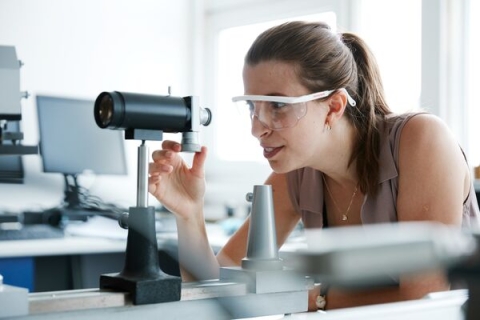

1 March 2018
2 min read
There is a mystery in cosmology: state of the art measurements of how fast the Universe is expanding don’t agree. This might be the first sign of new physics beyond the standard cosmological model, or it might be a sign that some of the measurements aren’t being interpreted correctly.
Astrophysicists from the University of Portsmouth and Lawrence Berkeley National Laboratory believe that strongly lensed Type Ia supernovae are the key to solving this mystery.
The farther away an object is in space, the longer its light takes to reach Earth. So the farther out we look, the further back in time we see. For decades, Type Ia supernovae have been exceptional distance markers because they are extraordinarily bright and similar in brightness no matter where they sit in the cosmos. By looking at these objects, scientists discovered that dark energy is propelling cosmic expansion.
Earlier this year scientists found an even more reliable distance marker – the first-ever strongly lensed Type Ia supernova.
Our new work shows that lensed supernovae are much better than quasars: it can take years to make the measurements with quasars, but with supernovae it’s only a matter of months."
Thomas Collett, Astrophysicist, Institute of Cosmology and Gravitation
These events occur when the gravitational field of a massive object—like a galaxy—bends and refocuses passing light from a Type Ia event behind it. This “gravitational lensing” causes the supernova’s light to appear brighter and sometimes in multiple locations, if the light rays travel different paths around the massive object.
Astrophysicist Thomas Collett, from Portsmouth’s Institute of Cosmology and Gravitation and co-author on the new paper said: “For the last few year I’ve been trying to measure the expansion rate with lensed quasars – cosmic beacons emanating from massive black holes in the centres of galaxies. Collaborators and I recently published a 3.8 per cent measurement of the expansion [1]. We got a value in between the other measurements, but we need more systems to be really sure that this is the final answer.
“Our new work shows that lensed supernovae are much better than quasars: it can take years to make the measurements with quasars, but with supernovae it’s only a matter of months. We forecast a thousand lensed supernovae will be in upcoming surveys, which will let us really nail down the cosmology.”
Ever since the cosmic microwave background result came out and confirmed the accelerating universe and the existence of dark matter, cosmologists have been trying to make better and better measurements of the cosmological parameters, and shrink the error bars.
Peter Nugent, Astropysicist, Berkeley Lab's Computational Cosmology Centre
Peter Nugent, an astrophysicist in Berkeley Lab’s Computational Cosmology Centre and co-author on the paper, said: “Ever since the cosmic microwave background result came out and confirmed the accelerating universe and the existence of dark matter, cosmologists have been trying to make better and better measurements of the cosmological parameters, and shrink the error bars.
“The error bars are now so small that we should be able to say ‘this and this agree,’ so the results presented last summer introduced a big tension in cosmology. Our paper presents a path forward for determining whether the current disagreement is real or whether it’s a mistake.”
Error bars are now so small that we should be able to say ‘this and this agree,’ so the results presented last summer introduced a big tension in cosmology. Our paper presents a path forward for determining whether the current disagreement is real or whether it’s a mistake.
Peter Nugent, Astropysicist, Berkeley Lab's Computational Cosmology Centre
The paper was published today in the Astrophysical Journal.
[1] Cosmic lenses support findings on accelerated universe expansion.
